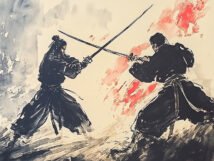Kumdo offers a unique blend of physical and mental benefits, making it an excellent choice for those seeking a comprehensive fitness routine. Whether you're looking to improve your physical health, manage stress, or connect with a rich cultural tradition, Kumdo provides a path to personal growth and wellness.
Key Takeaways
- Kumdo is a Korean martial art that combines cardio, diet, and exercise for holistic fitness.
- The practice improves cardiovascular health through high-intensity, continuous movements.
- Evening sessions of Kumdo help with diet control and metabolism boost.
- Suitable for all body types, Kumdo builds strength, flexibility, and endurance.
- Safety is ensured with protective gear, making it a low-risk activity for all ages.
- Stress relief is achieved through the rhythmic sound of bamboo and mental discipline.
- Kumdo's cultural significance adds depth to its practice, fostering pride and tradition.
Kumdo | Cardio, Diet, and Exercise Through Korean Martial Arts
Kumdo, a Korean martial art similar to Kendo, combines elements of cardio, diet, and exercise to create a holistic approach to physical fitness and mental discipline. This practice not only enhances endurance and strength but also fosters mental clarity and stress relief. Whether you are a beginner or a seasoned practitioner, Kumdo offers a unique blend of physical exertion and spiritual growth.
What is Kumdo?
Kumdo, which translates to "the way of the sword," is deeply rooted in Korean culture. It shares similarities with Kendo, a Japanese martial art, but incorporates distinct Korean techniques and philosophies. Practitioners use bamboo swords, known as "jukdo," to simulate combat, focusing on precision, speed, and control.
Cardio Benefits of Kumdo
High-Intensity Training
Kumdo classes are often likened to high-intensity interval training (HIIT), where participants engage in repetitive, vigorous movements. The practice involves a series of attacks and defenses, requiring quick reflexes and continuous motion. This relentless pace boosts cardiovascular fitness, ensuring that practitioners burn calories and improve heart health.
Endurance and Stamina
In Kumdo, there are no breaks between sequences, unlike other martial arts or fitness routines. This continuous engagement builds stamina and endurance. For instance, a typical Kumdo session might involve 30 minutes of nonstop sparring, which can burn up to 400 calories, contributing significantly to weight loss and cardiovascular health.
Kumdo and Diet: A Perfect Pairing
Evening Practice and Metabolism
Kumdo is commonly practiced in the evening, a time when many people struggle with snacking and unhealthy eating habits. The intense physical activity naturally suppresses appetite, leading to better diet choices. Moreover, exercising in the evening can boost metabolism, aiding in faster calorie burn even after the session ends.
Balanced Nutrition
A balanced diet complements the physical demands of Kumdo. Practitioners are encouraged to consume lean proteins, whole grains, and plenty of fruits and vegetables to support muscle repair and energy levels. Staying hydrated is equally crucial, though during practice, water breaks are minimal to maintain focus and discipline.
Physical Fitness and Kumdo
Building Strength and Flexibility
Kumdo is not just about speed and agility; it also enhances muscular strength. The repetitive swinging of the bamboo sword strengthens the arms, shoulders, and core. Additionally, the lunges and footwork involved in sparring improve lower body strength and flexibility.
Suitable for All Body Types
One of the most appealing aspects of Kumdo is its inclusivity. Whether you are tall, short, strong, or slender, there is a place for you in this martial art. For instance, shorter practitioners often find it easier to target opponents' waists, turning their stature into an advantage.
Safety in Kumdo
Protective Gear
Safety is a top priority in Kumdo. Practitioners wear protective gear, including a helmet, gloves, and chest protectors, reducing the risk of injury. The scoring system focuses on hitting specific areas like the head, shoulders, and waist, ensuring that strikes are controlled and deliberate.
Low Risk of Injury
Compared to other martial arts like judo or boxing, Kumdo has a lower risk of injury. The protective equipment and structured scoring system minimize physical harm, making it an ideal practice for individuals of all ages, including seniors.
Stress Relief Through Kumdo
The Therapeutic Sound of Bamboo
One unique stress-relieving aspect of Kumdo is the sound produced when the bamboo sword strikes its target. This sound can be likened to a percussion instrument, offering a rhythmic and calming effect. Many practitioners find the act of striking with the bamboo sword meditative, helping to reduce stress and improve mental focus.
Mental Discipline
Kumdo is not only a physical exercise but also a mental one. The concentration required during practice fosters mental clarity and discipline. Practitioners learn to focus their energy and emotions, leading to enhanced mental resilience and stress management.
Kumdo in the United States

US Hwa Rang Kwan: A Hub for Kumdo Enthusiasts
For those interested in practicing Kumdo in the United States, US Hwa Rang Kwan offers classes in Chantilly, VA, and Ellicott City, MD. This school teaches Kumdo with a focus on both traditional techniques and modern fitness benefits.
Cultural Significance
Kumdo holds significant cultural importance in Korea. Before each practice, participants bow to the national flag and observe a moment of silence, reflecting the martial art's origins in military training and its role in promoting national pride and cultural heritage.














